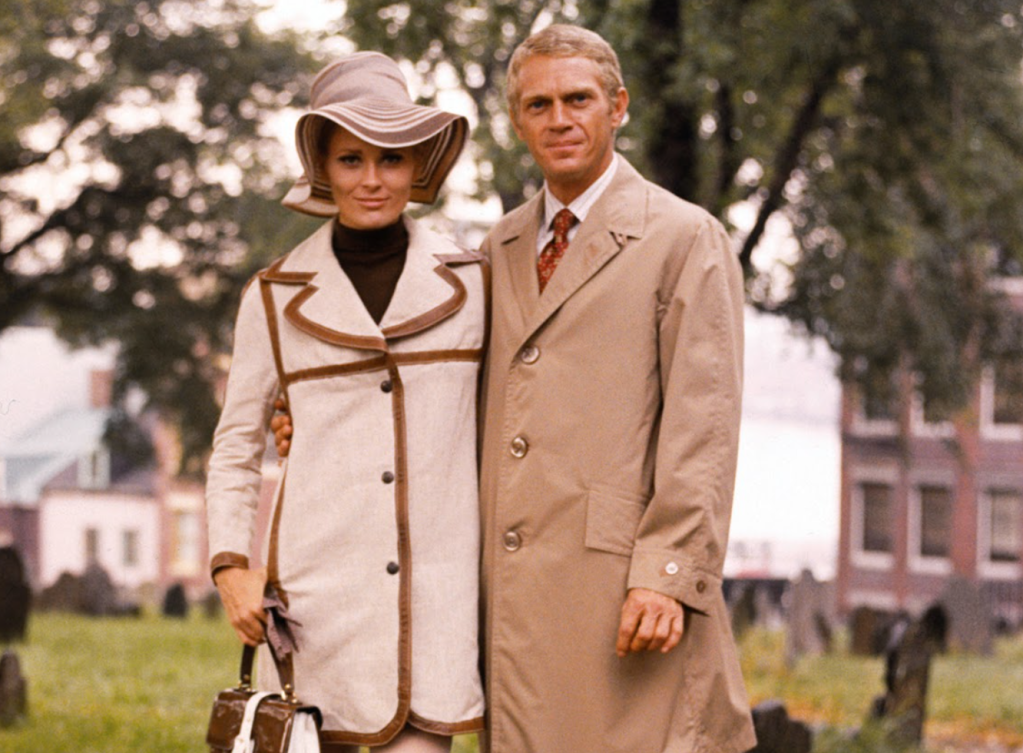Norman Jewison’s The Thomas Crown Affair (1968) would probably be boring if it were shot conventionally. There isn’t a lot to it. It’s about a cool-blonde millionaire named Thomas Crown (Steve McQueen) who, tired of how life’s possibilities have been made endless by the endlessness of his money, decides at the beginning of the film to set up and then execute the perfect crime. It’s a bank heist in Boston where his accomplices do not know each other and have never met him. (The one partner we see briefed by Crown in person walks into a dark hotel room where his new employer’s face is obscured in shadow; we gather everybody else has gotten their instructions by phone.)
For the rest of the film Crown enjoys rich-person leisure activities — stalking the skies in a private plane, zipping up and around lumps of sand in his dune buggy, showing off his polo-player prowess — while an impossibly glamorous independent insurance investigator, Vicki Anderson (Faye Dunaway), tries to uncover the bank-heist culprit. Her reputation for relentlessness gets tested by an attraction to Crown that will turn into a full-fledged affair, which gets to a serious-enough place that Crown is taking her to privately owned beachside lookout points to which he has not even taken his current girlfriend (Astrid Heeren).
Cinematographer Haskell Wexler and the movie’s team of editors, Hal Ashby, Ralph E. Winters, and Byron Brandt, have so much formal fun with the material that what might otherwise have been a rather rote heist-cum-romance film becomes electric. Scenes are constantly visually cut up into split screens, sometimes in the classic sense and other times with all-over-the-place kaleidoscopicness. Expensive surfaces are ogled. Even a chess game between Crown and Anderson is so lusciously shot that it persuasively doubles as foreplay, clarity over who’s winning made irrelevant by the teasing way Dunaway’s long pink nails caress the pieces in front of her, how her eyelashes flutter when she’s lost in thought, how her and Crown’s lips look when they touch them, lick them, in game-strategy puzzlement.

Faye Dunaway and Steve McQueen on the set of The Thomas Crown Affair.
Enhanced by the breeziness of Michael Legrand’s score, the look of The Thomas Crown Affair makes the suavity and style with which Crown approaches both life and elaborate crime into an aesthetic. What seems to matter less in the movie is whether it’s adequately thrilling (which I don’t think it is, since even during its few heist-movie sequences it’s still more interested in presentation than suspense) and more that you feel effectively immersed in a world where we are almost never confronted with things that are not expensive, beautiful, and a touch dangerous. (Though even the danger feels too sexy and playful to ever seem that grave.)
Detractors often characterize The Thomas Crown Affair’s style as overly compensatory because of how little it has going for it narratively. After seeing the film something like four or five times in the last decade-plus, never liking it that much for that reason, I could finally feel this time what Pauline Kael was talking about when she said that “seeing it is like lying in the sun flicking through fashion magazines and (as used to be said) feeling rich and beautiful beyond your wildest dreams.” The Thomas Crown Affair is a nice-to-look-at, appealingly shallow pleasure, or maybe I was just in the right mood to see it as such.

McQueen and Dunaway in The Thomas Crown Affair.
McQueen’s performances rarely move much above the surface. His chronic equanimity in movies tends to either come across as cool, like in Bullitt (1968), or as apathetic, like in The Getaway (1972). But it feels just right in a movie like The Thomas Crown Affair, where he plays a character so excitement-starved in his life of luxury that it’s no wonder he can stay level-headed even when things are potentially going south. Danger has taken him from the doldrums of boredom into newfound vitality. It’s like waiting to find out whether he’ll get away with his crime has finally given him something to live for. He’s laughing again. McQueen strikes you as unnatural in the handful of moments when he’s lost in fits of what the word “guffaw” was made for, but I like to think that this is just what it sounds like when someone who’s forgotten what it’s like to be delighted rediscovers the feeling.
The Thomas Crown Affair pulses with new life when Dunaway makes her entrance. It’s a grand one at an airport — a strut past terminals in a cream-colored floppy hat, bulbous gold loop earrings, and a blush-pink jacket that together give insurance investigation movie-star chicness. Her character’s wit and professional persistence give the film a feeling of danger it hardly has even when banks are being actively robbed. Those robberies are the handiwork of a man confident he’ll ultimately be able to move on with impunity. Dunaway’s Anderson presents the very real possibility of downfall, whether because of the illegal things Crown is doing or because of matters of the heart.
Dunaway and McQueen’s chemistry is as good as it is because you can sense their characters’ attraction to each other’s intellect maybe above anything else. Their mutual infatuation is made more urgent by the risk they pose to each other. Anderson’s gradual softening does not feel akin to the more misogynistic Taming of the Shrew-esque developments we’re used to seeing in movies of that era and before it: where a woman, independent and professionally successful, is hardly a woman at all until a man enters the picture. Anderson feels more like a stand-in for the viewer, hopeless not to get caught up in Crown’s alluring world, hopeful her part in it won’t just be another move in his game strategy. She’ll have to wait until the end to find out.
